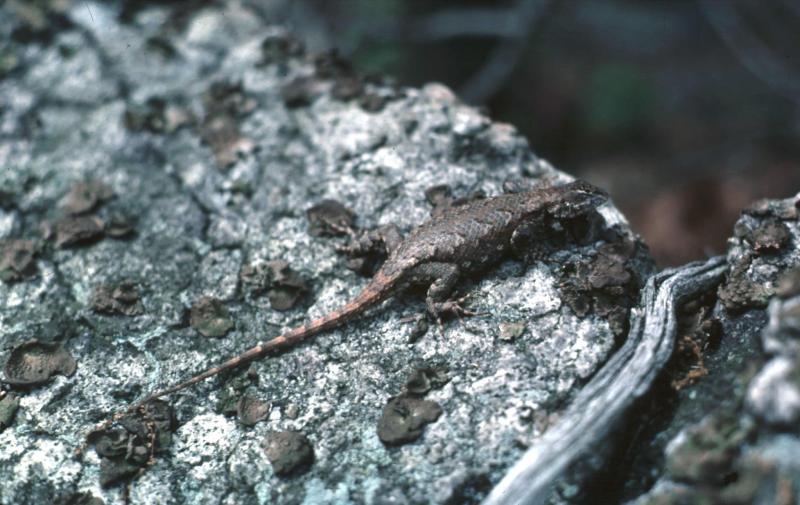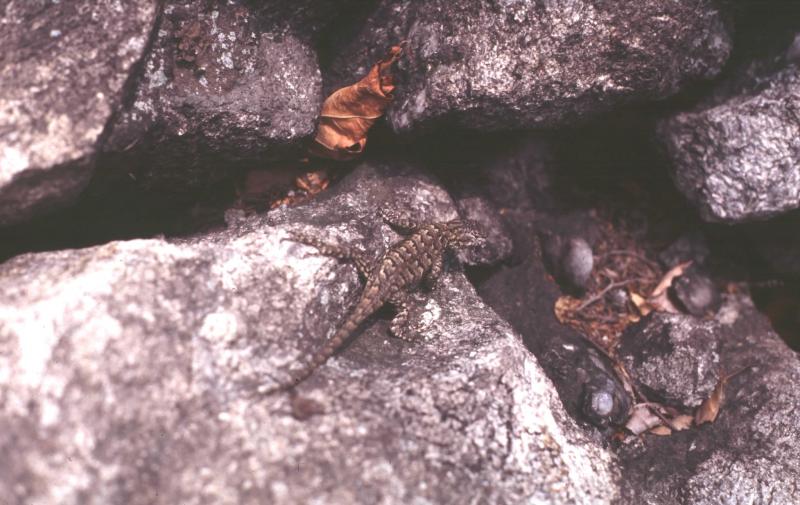Fence Lizard
Sceloporus undulatus (Bosc and Daudin, in Sonnini and Latreille, 1801)
- Class
- Reptilia (Reptiles)
- Family
- Phrynosomatidae (Spiny Lizards)
- State Protection
- Threatened
Listed as Threatened by New York State: likely to become Endangered in the foreseeable future. For animals, taking, importation, transportation, or possession is prohibited, except under license or permit. For plants, removal or damage without the consent of the landowner is prohibited.
- Federal Protection
- Not Listed
- State Conservation Status Rank
- S1
Critically Imperiled in New York - Especially vulnerable to disappearing from New York due to extreme rarity or other factors; typically 5 or fewer populations or locations in New York, very few individuals, very restricted range, very few remaining acres (or miles of stream), and/or very steep declines.
- Global Conservation Status Rank
- G5
Secure globally - Common in the world; widespread and abundant (but may be rare in some parts of its range).
Summary
Did you know?
Fence lizards are named for their habit of basking on rail fences. In other parts of their range, they are known as pine lizards because of their occurrence in open pine woods (Conant and Collins 1998).
State Ranking Justification
Five extant, naturally occurring, populations are known and there is one introduced population on Staten Island that has persisted since 1942 when 29 individuals were released. When appropriate separation distances are taken into consideration, the five naturally occurring populations would be combined into two occurrences. There are three occurrences when the introduced population is considered. There is some evidence of decline in one location and two additional locations where this species was recorded in the 1920's, 1930's, and 1950's are now believed to be extirpated for unknown reasons.
Short-term Trends
The five extant populations appear to be stable, although there may be some evidence of decline in recent years at one location.
Long-term Trends
Of the seven naturally occurring populations known, two have become extirpated for unknown reasons. Although most of the remaining populations have been known for decades, there is insufficient population data to indicate trends for these locations.
Conservation and Management
Threats
While the habitat occupied by this species is not largely threatened by development, mining, or other uses there is some evidence that the species, like other uncommon reptiles, is subject to some degree of illegal collecting.
Research Needs
Standardized survey protocols should be developed. Age and sex ratios, longevity, age at sexual maturity, survivorship of young, predator-prey relationships, and habitat suitability should be determined.
Habitat
Habitat
Naturally occurring fence lizard populations are confined to the Hudson Highlands region of the state. These areas are characterized by steep slopes with extensive open rocky areas that are surrounded by mixed-deciduous, oak-dominated, forests. The introduced population on Staten Island has been documented in sandy openings and pine woods within post oak-blackjack oak barren communities.
Associated Ecological Communities
- Appalachian oak-hickory forest*
(guide)
A hardwood forest that occurs on well-drained sites, usually on ridgetops, upper slopes, or south- and west-facing slopes. The soils are usually loams or sandy loams. This is a broadly defined forest community with several regional and edaphic variants. The dominant trees include red oak, white oak, and/or black oak. Mixed with the oaks, usually at lower densities, are pignut, shagbark, and/or sweet pignut hickory.
- Chestnut oak forest
(guide)
A hardwood forest that occurs on well-drained sites in glaciated portions of the Appalachians, and on the coastal plain. This forest is similar to the Allegheny oak forest; it is distinguished by fewer canopy dominants and a less diverse shrublayer and groundlayer flora. Dominant trees are typically chestnut oak and red oak.
- Oak-tulip tree forest*
(guide)
A hardwood forest that occurs on moist, well-drained sites in southeastern New York. The dominant trees include a mixture of five or more of the following: red oak, tulip tree, American beech, black birch, red maple, scarlet oak, black oak, and white oak.
- Pitch pine-oak-heath rocky summit
(guide)
A community that occurs on warm, dry, rocky ridgetops and summits where the bedrock is non-calcareous (such as quartzite, sandstone, or schist), and the soils are more or less acidic. This community is broadly defined and includes examples that may lack pines and are dominated by scrub oak and/or heath shrubs apparently related to fire regime.
- Post oak-blackjack oak barrens
(guide)
Open barrens on upper slopes and low ridges characterized by the presence of stunted individuals of post oak, scarlet oak, and blackjack oak. There is a sparse heath and grass ground cover growing in very dry, deep, exposed sand overlying a clay subsoil.
- Rocky summit grassland
(guide)
A grassland community that occurs on rocky summits and exposed rocky slopes of hills. Woody plants are sparse and may be scattered near the margin of the community. Small trees and shrubs may be present at low percent cover.
* probable association but not confirmed.
Associated Species
- Five-lined Skink (Plestiodon fasciatus)
Range
New York State Distribution
All extant, naturally occurring, locations are found in the Hudson Highlands along a narrow corridor in two counties along the east side of the Hudson River. An introduced population exists on Staten Island.
Global Distribution
The range of the northern subspecies (Sceloporus undulatus hyacinthinus) extends primarily from southern New Jersey to central Georgia and west to Louisiana and eastern Kansas and eastern Texas. Isolated colonies are present in southeastern New York, northeastern Pennsylvania, and there is an isolated record from Missouri (Conant and Collins 1998). The southern subspecies (Sceloporus undulatus undulatus) occurs further south to eastern Louisiana and central Florida and the range of the two subspecies overlap in central Alabama and Georgia.
Best Places to See
- As this species is occasionally vulnerable to illegal collection, no naturally occurring populations are listed.
Identification Comments
Identifying Characteristics
The northern fence lizard (Sceloporus undulatus hyacinthinus) is a small gray or brown spiny lizard measuring 4 to 7.25 inches(10 to 18.4 cm) in length. The belly and sides of males is hyacinth to greenish-blue in color and is bordered by black towards the center of the belly. Males also have a broad bluish area at the base of the throat and this bluish area is also surrounded by black that is often split into two parts. Dorsal crosslines on males are indistinct or absent. Females have a series of dark, undulating crosslines across the back. Females also have a yellow, orange, or reddish coloration at the base of the tail and have a whitish belly with scattered black flecks. Females have small amounts of pale blue coloration at the sides of the belly and throat. The young are patterned similarly to females, but are darker and duller and average 1.6 to 2.25 inches (4.1 to 5.7 cm) at hatching (Conant and Collins 1998).
Characters Most Useful for Identification
The gray-brown coloration, presence of wavy lines across the back, and rough-textured skin due to the keeled scales are useful in separating this species from other New York State lizards.
Best Life Stage for Proper Identification
Adults, juveniles, and hatchlings are all similar in appearance and are fairly easy to identify.
Behavior
Fence lizards are often observed resting on rocks, logs, and stumps in open habitat. When surprised, they will often quickly retreat into rock crevices or under other cover. This species is also known for retreating to a nearby tree, climbing a short distance, and remaining motionless on the opposite side of the tree. If approached again, this behavior is repeated (Conant and Collins 1998).
Diet
Fence lizards eat insects, spiders, other arthropods, snails, and hatchling lizards (Stebbins 1985).
Best Time to See
Fence lizards are generally active from late April until early October and are believed to be inactive during the hottest part of the day in the summer. The species hibernates in burrows, rotting logs, and rock crevices.
- Present
- Active
The time of year you would expect to find Fence Lizard present and active in New York.
Similar Species
- Five-lined Skink (Plestiodon fasciatus)
Five-lined skinks occur with fence lizards at all Hudson River Valley sites. This species has five yellowish stripes on a black background and these stripes run lengthwise along the body. Juvenile skinks have a brilliant blue tail. The pattern on older skinks becomes less conspicuous and the tail turns gray. Male skinks develop an orange-red coloration on the jaws during the spring breeding season (Conant and Collins 1998).
Fence Lizard Images
Taxonomy
Fence Lizard
Sceloporus undulatus (Bosc and Daudin, in Sonnini and Latreille, 1801)
- Kingdom Animalia
- Phylum Craniata
- Class Reptilia
(Reptiles)
- Order Squamata
(Lizards, Snakes and Amphisbaenians)
- Family Phrynosomatidae (Spiny Lizards)
- Order Squamata
(Lizards, Snakes and Amphisbaenians)
- Class Reptilia
(Reptiles)
- Phylum Craniata
Additional Resources
References
Ashton, R. E., Jr., and P. S. Ashton. 1985. Handbook of reptiles and amphibians of Florida. Part two. Lizards, turtles & crocodilians. Windward Pub., Inc., Miami. 191 pp.
Behler, J. L., and F. W. King. 1979. The Audubon Society field guide to North American reptiles and amphibians. Alfred A. Knopf, New York. 719 pp.
Conant, R., and J. T. Collins. 1998. A field guide to reptiles and amphibians: eastern and central North America. Third edition, expanded. Houghton Mifflin Co., Boston, Massachusetts. 616 pp.
DeGraaf, R.M. and D.D. Rudis. 1981. Forest habitat for reptiles and amphibians of the northeast. United States Department of Agriculture, Forest Service Eastern Region, Milwaukee, WI. 239 pp.
Fitch, H. S. 1970. Reproductive cycles of lizards and snakes. Univ. Kansas Museum Natural History Miscellaneous Publication 52:1-247.
Hammerson, G. A. 1982b. Amphibians and reptiles in Colorado. Colorado Division of Wildlife, Denver. vii + 131 pp.
Minton, S. A., Jr. 1972. Amphibians and reptiles of Indiana. Indiana Academy Science Monographs 3. v + 346 pp.
New York Natural Heritage Program. 2024. New York Natural Heritage Program Databases. Albany, NY.
New York State Department of Environmental Conservation, Division of Fish, Wildlife, and Marine Resources. 2006. New York State Comprehensive Wildlife Conservation Strategy. Albany, NY: New York State Department of Environmental Conservation.
Stebbins, R. C. 1985a. A field guide to western reptiles and amphibians. Second edition. Houghton Mifflin Company, Boston, Massachusetts. xiv + 336 pp.
Tinkle, D. W., and A. E. Dunham. 1986. Comparative life histories of two syntopic sceloporine lizards. Copeia 1986:1-18.
Links
About This Guide
Information for this guide was last updated on: April 4, 2006
Please cite this page as:
New York Natural Heritage Program. 2024.
Online Conservation Guide for
Sceloporus undulatus.
Available from: https://guides.nynhp.org/fence-lizard/.
Accessed July 26, 2024.


